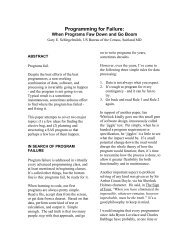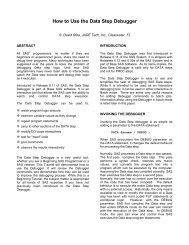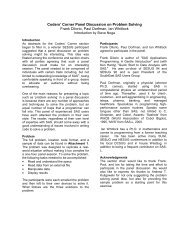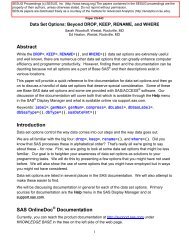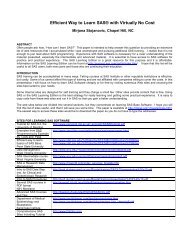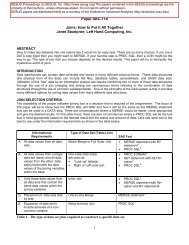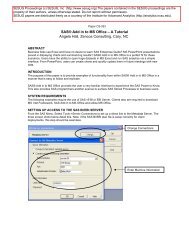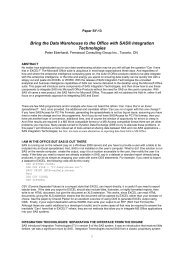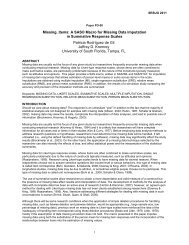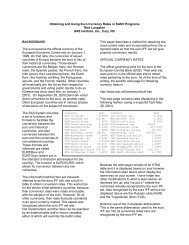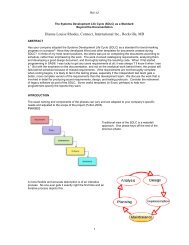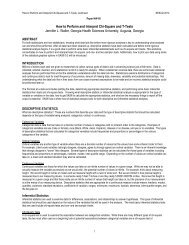A SAS® Macro to Compute Added Predictive Ability of New Markers ...
A SAS® Macro to Compute Added Predictive Ability of New Markers ...
A SAS® Macro to Compute Added Predictive Ability of New Markers ...
You also want an ePaper? Increase the reach of your titles
YUMPU automatically turns print PDFs into web optimized ePapers that Google loves.
Paper SDA-07<br />
A <strong>SAS®</strong> <strong>Macro</strong> <strong>to</strong> <strong>Compute</strong> <strong>Added</strong> <strong>Predictive</strong> <strong>Ability</strong> <strong>of</strong> <strong>New</strong> <strong>Markers</strong> Predicting a<br />
Dicho<strong>to</strong>mous Outcome<br />
Kevin F Kennedy, St. Luke’s Hospital-Mid America Heart Institute, Kansas City, MO<br />
Michael J Pencina, Dept. <strong>of</strong> Biostatistics, Bos<strong>to</strong>n University, Harvard Clinical Research<br />
Institute, Bos<strong>to</strong>n, MA<br />
ABSTRACT<br />
Risk prediction is an important field in applied statistics. For example, in clinical research, predicting the<br />
development <strong>of</strong> adverse medical conditions is the object <strong>of</strong> many studies. However, this concept is multi-disciplinary.<br />
Many published models exist <strong>to</strong> predict dicho<strong>to</strong>mous outcomes, ranging widely from a model <strong>to</strong> predict winners in<br />
the NCAA basketball <strong>to</strong>urnament <strong>to</strong> a recently published risk model <strong>to</strong> predict the likelihood <strong>of</strong> a bleeding<br />
complication after percutaneous coronary intervention. It is important <strong>to</strong> note, however, these models are dynamic,<br />
as changes in population and technology lead <strong>to</strong> discovery <strong>of</strong> new and better methods <strong>to</strong> predict outcomes. An<br />
important consideration is when <strong>to</strong> add new markers <strong>to</strong> existing models. While a significant p-value is an important<br />
condition, it does not necessarily imply an improvement in model performance. Traditionally, receiver operating<br />
characteristic (ROC) curves and its corresponding area under the curve (AUC) are used <strong>to</strong> compare models, with a<br />
statistical test due <strong>to</strong> DeLong et al. for two correlated AUCs. However, the clinical relevance <strong>of</strong> this metric has been<br />
questioned by researchers 1,2,3 . To address this issue, Pencina and D’Agostino 1 have proposed two statistics <strong>to</strong><br />
evaluate the significance <strong>of</strong> novel markers. The Integrated Discrimination Improvement (IDI) measures the new<br />
model’s improvement in average sensitivity without sacrificing average specificity. The Net Reclassification<br />
Improvement (NRI) measures the correctness <strong>of</strong> reclassification <strong>of</strong> subjects based on their predicted probabilities <strong>of</strong><br />
events using the new model with the option <strong>of</strong> imposing meaningful risk categories.<br />
Currently, only the AUC can be obtained directly from SAS (proc logistic). In contrast, the AUC as well as the NRI<br />
and IDI, can both be outputted in R with the ImproveProb function under the Hmisc library (Click Here). In this paper<br />
we present a single SAS macro which allows calculation <strong>of</strong> all three measures with several user-defined<br />
specifications.<br />
INTRODUCTION<br />
This paper is going <strong>to</strong> cover situations where we are comparing 2 models predicting a yes/no outcome without a<br />
time-<strong>to</strong>-event element. This can be done using a variety <strong>of</strong> different models, including; logistic, log-binomial, or<br />
Modified Poisson 6,12 approach for relative risk estimation. For example, consider comparing 2 nested logistic<br />
regression models <strong>to</strong> predict a dicho<strong>to</strong>mous outcome with the main difference being model 2 includes a variable for<br />
a new marker as a predic<strong>to</strong>r:<br />
Model1<br />
: logit(<br />
y)<br />
= α + β x + ... + β x<br />
Model2<br />
: logit(<br />
y)<br />
= α + β x + ... + β x + β<br />
1 1 n n n+<br />
1 n+<br />
1<br />
The output <strong>of</strong> each model will be a predicted probability <strong>of</strong> experiencing an event, and each individual in the dataset<br />
will have 2 probabilities, one from each model. Our goal is <strong>to</strong> evaluate how much the new variables <strong>to</strong> model2 add<br />
<strong>to</strong> prediction compared <strong>to</strong> model1.<br />
AUC<br />
Difference in the area under the receiver operating characteristic curve (AUC) is a common method <strong>to</strong> compare two<br />
models. AUC is a measure <strong>of</strong> model discrimination (i.e. how well the model separates subjects who did and did not<br />
experience an event). It essentially depicts a trade<strong>of</strong>f between the benefit <strong>of</strong> a model (true positive or sensitivity) vs.<br />
its costs (false positive or 1-specificity). AUC is computed by comparing all possible pairs in a dataset between<br />
individuals experiencing and not experiencing an event. For example, a dataset with 100 events and 1000 nonevents<br />
would have 100*1000=100,000 pairs. In each pair the predicted probability is compared. If the individual<br />
experiencing an event has a higher predicted probability, that pair would be labeled ‘concordant’ and assigned a<br />
value <strong>of</strong> 1. Conversely, if the individual experiencing an event has a lower probability the pair would be labeled<br />
‘discordant’ and assigned a value <strong>of</strong> 0. AUC would be an average <strong>of</strong> the 1s and 0s (and 0.5s for identical values).<br />
AUC ranges from 0.5 (no discrimination) <strong>to</strong> 1 (perfect discrimination); however, values close <strong>to</strong> 1 are very rarely seen<br />
in contemporary data 3,7 . The value <strong>of</strong> baseline AUC is important, but in our context the focus is on the contribution<br />
<strong>of</strong> anew marker. To address this scenario, DeLong 4 presented a method for comparing 2 correlated AUCs. Prior <strong>to</strong><br />
SAS version 9.2 you could run the %roc macro located on the SAS website 8 . However, if you are running a logistic<br />
model in 9.2 this comparison can be done with the two new statements that were added <strong>to</strong> proc logistic (roc and<br />
roccontrast).<br />
1<br />
1<br />
1<br />
n<br />
n<br />
x
Sample code for SAS 9.2 Proc Logistic:<br />
proc logistic data=auc;<br />
model eve=x1 x2 x3 x4 x5;<br />
roc 'first' x1 x2 x3 x4;<br />
roc 'second' x1 x2 x3 x4 x5;<br />
roccontrast reference('first')/estimate;<br />
run;<br />
The above code will return a comparison <strong>of</strong> model 1 (with the first 4 covariates) with model 2 (containing the<br />
additional covariate). For a pre-version 9.2 example go <strong>to</strong> the SAS website [Click Here].<br />
Many advantages exist for reporting the AUC. First, it is a well known statistic, commonly seen in any model<br />
predicting a dicho<strong>to</strong>mous outcome. Second, it is the default output in most all statistical s<strong>of</strong>tware including proc<br />
logistic in SAS. Third, there are recommend ranges for an excellent/good/poor value for AUC making it easier <strong>to</strong><br />
evaluate the model. In their textbook, Hosmer and Lemeshow 7 consider AUC values <strong>of</strong> 0.7 <strong>to</strong> 0.8 <strong>to</strong> show<br />
acceptable discrimination, values <strong>of</strong> 0.8 <strong>to</strong> 0.9 <strong>to</strong> indicate excellent discrimination, and values <strong>of</strong> 0.9 <strong>to</strong> show<br />
outstanding discrimination. However, they also note how unusual it is <strong>to</strong> observe AUC values over .9 and how it<br />
could cause issues in the model due <strong>to</strong> complete separation <strong>of</strong> data.<br />
There are also disadvantages <strong>to</strong> the AUC. First, it is a rank based statistic. A pair <strong>of</strong> individuals with probabilities<br />
0.5 and 0.51 would be treated the same as with probabilities 0.1 and 0.9. Second, it focuses only on discrimination<br />
which is not the only and may not be the most important in the context <strong>of</strong> risk prediction. Third, it is very difficult for a<br />
new marker <strong>to</strong> significantly change the value <strong>of</strong> AUC 3 . Fourth, the magnitude <strong>of</strong> improvement in AUC is not nearly<br />
as meaningful as the value <strong>of</strong> AUC itself. For this reason it is very difficult <strong>to</strong> use increase in the AUC <strong>to</strong> justify<br />
adding new markers <strong>to</strong> a model even though these markers may have a major impact at the individual level 3 .<br />
The next two measures (IDI/NRI) attempt <strong>to</strong> quantify the added predictive ability <strong>of</strong> a new marker by contributing<br />
additional information beyond the AUC. IDI attempts <strong>to</strong> add <strong>to</strong> AUC by quantifying how far apart in probabilities the<br />
events and non-events are when adding a new marker. And NRI attempts <strong>to</strong> quantify how many individuals are<br />
correctly “reclassified” when adding a new marker.<br />
IDI<br />
IDI is a measure <strong>of</strong> the new model’s improvement in average sensitivity (true positive rate) without sacrificing its<br />
average specificity (true negative rate). In comparing the models, IDI measures the increment in the predicted<br />
probabilities for the subset experiencing an event and the decrement for the subset not experiencing an event (see<br />
figure1). This adds an important element that AUC lacks. The AUC is a rank based statistic in which all that matters<br />
is which probability is higher or lower, whereas IDI gives a measure <strong>of</strong> how far apart on average they are.<br />
Absolute _ IDI = ( p _ event _ 2 − p _ event _1)<br />
+ ( p _ nonevent _1<br />
− p _ nonevent _ 2)<br />
(1)<br />
p _ event _ 2 − p _ nonevent _ 2<br />
Re lative _ IDI =<br />
p _ event _1<br />
− p _ nonevent _1<br />
where :<br />
p _ event _ 2 is<br />
the mean<br />
Mean Predicted Probability in %<br />
50<br />
40<br />
30<br />
20<br />
10<br />
0<br />
predicted<br />
probability<br />
Mean ‘p’<br />
decreased by 3%<br />
for non-events<br />
.03/.15=20%<br />
improvement<br />
15<br />
−1<br />
<strong>of</strong><br />
the subset experiencing<br />
an event using model2<br />
. 25 − . 12<br />
Relative_I DI = − 1 = 1 . 6<br />
. 2 − . 15<br />
12<br />
( . 25 − . 2 ) + ( . 15 − . 12 ) . 08<br />
Absolute_I DI =<br />
=<br />
2<br />
Mean ‘p’<br />
increased by<br />
5% for events<br />
.05/.2=25%<br />
improvement<br />
20<br />
25<br />
Model1 Model2<br />
Model1 Model2<br />
Non-Events Events<br />
Figure 1: Graphical Depiction <strong>of</strong> IDI<br />
One caveat is that absolute IDI depends on the event rate observed in a given data. If the event rate <strong>of</strong> interest is<br />
only 3% then the absolute IDI value will be seemingly small. This is where relative IDI is useful—it returns a<br />
percentage (no units). Pencina and D’Agostino provide an example where the absolute IDI is only 0.009 but<br />
(2)
epresents a 13% improvement on the relative scale. In Figure1 the relative IDI value <strong>of</strong> 1.6 indicates that the<br />
difference in predicted probabilities between events and non-events increased 1.6 times between model1 and<br />
model2.<br />
NRI<br />
NRI is based on a concept similar <strong>to</strong> IDI but its focus is on the upward and downward movement <strong>of</strong> predicted risks<br />
among those with and without events. Upward and downward movement can be defined based on simple increases<br />
and decreases in predicted risks using model2 instead model1, or applying categories and requiring movement<br />
between categories. NRI evaluates the ‘net’ number <strong>of</strong> individuals reclassified correctly using model2 over model1.<br />
This is done by calculating how many individuals experiencing an event increased in absolute risk or risk category<br />
(e.g., from medium <strong>to</strong> high) and how many individuals not experiencing an event decreased in absolute risk or risk<br />
category (e.g., medium <strong>to</strong> low).<br />
NRI<br />
⎡⎛<br />
# Events moving up<br />
= ⎢⎜<br />
⎣⎝<br />
# <strong>of</strong> Events<br />
⎡⎛<br />
# Non - events moving<br />
⎢⎜<br />
⎣⎝<br />
# <strong>of</strong> Non - events<br />
⎞<br />
⎟<br />
⎠<br />
down<br />
⎛<br />
− ⎜<br />
⎝<br />
⎞<br />
⎟<br />
⎠<br />
# Events moving down ⎞⎤<br />
⎟⎥<br />
+<br />
# <strong>of</strong> Events ⎠⎦<br />
⎛<br />
− ⎜<br />
⎝<br />
# Non<br />
#<br />
- events moving<br />
<strong>of</strong> Non - events<br />
3<br />
up ⎞⎤<br />
⎟⎥<br />
⎠⎦<br />
The no category option can be seen as the categorical version with as many categories as there are estimated risks.<br />
In this definition any movement in probabilities counts as an up or down movement. This is the definition used by<br />
the ImproveProb function in R. Using this classification if an individual’s probability using model 1 was 0.17 and<br />
using model 2 it became 0.18 this would be considered an upward movement. The category-based version involves<br />
a user defined classification. This requires more intimate knowledge <strong>of</strong> the data and population; for example one<br />
could define 3 groups: low (probability20%). Here if<br />
an individual was a ‘low’ in model 1 but became a ‘moderate’ in model 2 it would be considered an upward<br />
movement.<br />
There are advantages <strong>to</strong> both category-based and category-free NRI. With the category-free definition the user<br />
doesn’t have <strong>to</strong> worry about determining meaningful categories, with the potential drawback <strong>of</strong> a loss <strong>of</strong> practical<br />
interpretation. The “user” defined classification can be easily seen in two nXn tables (see tables 1&2 below) if one<br />
imposes only a few groups, and can be expressed in more practical terms (eg. 10 people who had an event went<br />
from “medium” risk <strong>to</strong> “high” risk). Importantly, the developed macro has options <strong>to</strong> compute NRI using either or<br />
both <strong>of</strong> these definitions, a helpful addition <strong>to</strong> current statistical s<strong>of</strong>tware packages.<br />
NRI COMPUTATION EXAMPLE:<br />
A dataset with 100 events and 200 non-events, using 3 user defined categories: 20% (high). By making 2 separate (event and non-event) crosstabs <strong>of</strong> model1 groups by model2 groups one can<br />
calculate NRI, by counting the numbers on the <strong>of</strong>f-diagonal:<br />
Table1: Crosstab for Events (n=100)<br />
Model 1<br />
Low<br />
Mod<br />
High<br />
Low<br />
10<br />
3<br />
2<br />
Model 2<br />
Mod<br />
8<br />
30<br />
5<br />
High<br />
2<br />
10<br />
30<br />
20 Events moving up<br />
10 Events moving down<br />
70 Events not moving<br />
Net <strong>of</strong> 10/100 (10%) <strong>of</strong><br />
events getting<br />
reclassified correctly<br />
Table2: Crosstab for Non-events (n=200)<br />
Model 1<br />
Low<br />
Mod<br />
High<br />
Low<br />
50<br />
20<br />
5<br />
Model 2<br />
⎡ ⎛ 20 ⎞ ⎛ 10 ⎞ ⎤ ⎡ ⎛ 35 ⎞ ⎛ 15 ⎞ ⎤<br />
NRI = ⎢ ⎜ ⎟ − ⎜ ⎟ ⎥ + ⎢ ⎜ ⎟ − ⎜ ⎟ ⎥ = . 2<br />
⎣ ⎝ 100 ⎠ ⎝ 100 ⎠ ⎦ ⎣ ⎝ 200 ⎠ ⎝ 200 ⎠ ⎦<br />
Mod<br />
5<br />
40<br />
10<br />
High<br />
0<br />
10<br />
60<br />
15 Non-events moving<br />
up<br />
35 Non-events moving<br />
down<br />
150 Non-events not<br />
moving<br />
Net <strong>of</strong> 20/200 (10%) <strong>of</strong><br />
non-events getting<br />
reclassified correctly<br />
It is important <strong>to</strong> remember that NRI is dependent on the groups chosen. For example, the results could be different<br />
had the groups been 30%, by defining 4 groups instead <strong>of</strong> 3, or using category-free. Due <strong>to</strong><br />
this issue, defining your NRI strategy before data analysis is essential..<br />
ADDITIONAL MEASURES: CALIBRATION<br />
So far this paper has discussed 3 important measures for evaluating the added predictive ability: increase in AUC,<br />
IDI, and NRI. However, one very important measure also needs <strong>to</strong> be addressed: calibration. Calibration quantifies<br />
how close the predicted probabilities match the actual experience. It is very important <strong>to</strong> when adding a new marker<br />
(3)
<strong>to</strong> a model that there is at least no worsening in model calibration (hopefully we might see an improvement).<br />
A traditional measure <strong>of</strong> calibration is the Hosmer-Lemeshow Chi-Square Test. This test breaks the data in<strong>to</strong> “j”<br />
equal groups (frequently 10) based on ordered predicted probabilities and compares means <strong>of</strong> predicted predicted<br />
probabilities <strong>to</strong> observed rates. This test statistic can be compared <strong>to</strong> a Chi-square distribution with j-2 degrees <strong>of</strong><br />
freedom, where a sufficiently large value will indicate a poorly calibrated model (eg, low p-values represent lack <strong>of</strong> fit)<br />
⎡<br />
2<br />
⎛ n j n j ⎞ ⎤<br />
⎢⎜<br />
yij<br />
p<br />
⎟ ⎥<br />
ij<br />
j ⎢⎜∑<br />
−∑<br />
⎟ ⎥<br />
i i<br />
HL<br />
⎢⎝<br />
= 1 = 1<br />
2<br />
j =<br />
⎠ ⎥<br />
∑ ~ χ ( j − 2)<br />
⎢ n j<br />
⎥<br />
j=<br />
1 ⎢ pij<br />
* ( 1−<br />
p j ) ⎥<br />
⎢ ∑<br />
⎥<br />
i=<br />
1 ⎢⎣<br />
⎥⎦<br />
Where :<br />
j is<br />
n<br />
y<br />
p<br />
p<br />
j<br />
ij<br />
ij<br />
j<br />
the number <strong>of</strong> groups (usually 10)<br />
is the number <strong>of</strong> subjects in the j' th group<br />
is the i'th<br />
outcome <strong>of</strong> the j' th group (0 or 1)<br />
is the i' th predicted probability<br />
<strong>of</strong> the j' th group<br />
is the mean predicted probability<br />
<strong>of</strong> the j' th group<br />
This test statistic has recently come under scrutiny by the original authors since it is driven by the number <strong>of</strong> groups<br />
and how they are defined. In a paper by Hosmer and Lemeshow they show that this test obtains different results<br />
from various statistical packages due <strong>to</strong> the algorithm used <strong>to</strong> select cutpoints. In the same paper they recommend<br />
other tests and the author refers the reader <strong>to</strong> this publication 5 . In Appendix A we provide a SAS macro <strong>to</strong> compute<br />
the HL test statistic with a default <strong>of</strong> 10 groups for any set <strong>of</strong> predicted probabilities and observed outcomes., This<br />
macro is then called in Appendix B for default output along with AUC/IDI/NRI. Alternatively, in SAS you can use proc<br />
logistic’s “lackfit” option <strong>to</strong> compute the test statistic, however, the macro in appendix A is not limited <strong>to</strong> a logistic<br />
model. Importantly, there exists a SAS macro <strong>to</strong> compute the other statistics in the Hosmer paper and was<br />
presented at the 2001 SAS Global Forum (SUGI 26) 8 using proc IML. Additionally the resid function in R computes<br />
one <strong>of</strong> the alternatives in the Hosmer & Lemeshow paper, unweighted sum <strong>of</strong> squares. (Click Here).<br />
SAS MACRO TO OBTAIN OUTPUT<br />
The entire code is in Appendix A&B and for more examples contact the corresponding author. In addition a worked<br />
macro call is provided in Appendix C using the Cars data from the sashelp library.<br />
%macro add_predictive(data= , y= , p_old= , p_new=, nripoints=%str(),<br />
hoslemgrp=10);<br />
This macro only has 4 required user inputs. By entering just the data, outcome(y), initial probabilities, and final<br />
probabilities, the user will obtain output on AUC, IDI, NRI using the category-free definition, and the Hosmer-<br />
Lemeshow chi-square test (see appendix C for an example using the macro). Below are the optional inputs:<br />
1) If the user wants defined NRI groups (i.e. 20%) enter: nripoints=.1 .2<br />
2) If the user wants a different number <strong>of</strong> groups for the HL test (other than 10) enter: hoslemgrp=#<br />
TIME TO EVENT ANALYSIS<br />
It’s important <strong>to</strong> note that this paper was set up under a model <strong>of</strong> predicting a dicho<strong>to</strong>mous outcome without a time<strong>to</strong>-event<br />
element. This was done for a few reasons. First, I intended this paper <strong>to</strong> serve as an introduction <strong>to</strong> a very<br />
important statistical concept and using this strategy allowed for ease <strong>of</strong> interpretation and explanation. Second,<br />
predicting a yes/no outcome is a very common situation in essentially all areas <strong>of</strong> research, making this macro<br />
applicable in many fields. Third, the new c-statistic options under version 9.2 in SAS with the ROC and<br />
ROCCONTRAST statements was important enough <strong>to</strong> warrant the restrictive case.<br />
However, these or equivalent measures are available for time-<strong>to</strong>-event data. Interestingly, the initial paper on<br />
IDI/NRI was used analyzing the Framingham data (Click Here) which is a long term study; hence, time-<strong>to</strong>-event was<br />
used as the frame <strong>of</strong> the first discussion. Because <strong>of</strong> this, using predicted rates from survival analysis (eg. Mortality<br />
probability) could be inserted in<strong>to</strong> the macro <strong>to</strong> get correct estimates <strong>of</strong> IDI and NRI. The difference comes in the<br />
calculation <strong>of</strong> the C-statistic and Hosmer-Lemeshow. Currently there is a comparable AUC measure for Survival<br />
data 9 along with tests <strong>of</strong> correlated AUC measures 10 and also papers <strong>to</strong> help compute survival AUC 11 .<br />
4
CONCLUSION<br />
Predicting dicho<strong>to</strong>mous events will continue <strong>to</strong> be an important aspect <strong>of</strong> research. Additionally, improving already<br />
useful models will be just as important. This paper presented 4 important measures in determining model<br />
performance and improvement by the addition <strong>of</strong> new markers. Pencina and D’Agostino 1 state, “the choice <strong>of</strong> the<br />
improvement metric should take in<strong>to</strong> account the question <strong>to</strong> be answered”. If the primary goal is <strong>to</strong> determine if an<br />
individual falls above or below a specific cut-<strong>of</strong>f then NRI will probably be the preferred metric. On the other hand, if<br />
no cut-<strong>of</strong>fs exist it may be best <strong>to</strong> look at category-free NRI, IDI and AUC. Also, the example from Pencina and<br />
D’Agostino shows a case where the addition <strong>of</strong> a new variable <strong>to</strong> a model results in a very small change in AUC but<br />
a marked improvement in IDI and NRI. The small change in AUC is explained more fully by Pepe et al. 3 and may<br />
justify not solely using increase in AUC as the guideline for model improvement but rather a combination <strong>of</strong> metrics.<br />
It is also important <strong>to</strong> note that other fac<strong>to</strong>rs will play a role in determining whether <strong>to</strong> add a new marker. For<br />
example, if the new marker is more difficult and expensive <strong>to</strong> obtain guidelines on what constitutes a significant<br />
improvement in model performance will likely be stricter. It is important <strong>to</strong> keep in mind all <strong>of</strong> these fac<strong>to</strong>rs in<br />
assessing model performance.<br />
REFERENCES<br />
1) Pencina MJ, D'Agostino RB Sr, D’Agostino RB Jr. Evaluating the added predictive ability <strong>of</strong> a new marker:<br />
From area under the ROC curve <strong>to</strong> reclassification and beyond. Stat Med 2008; 27:157-72.<br />
2) Cook NR. Use and Misuse <strong>of</strong> the receiver operating characteristics curve in risk prediction. Circulation 2007;<br />
115:928-935.<br />
3) Pepe MS, Janes H, Long<strong>to</strong>n G, Leisenring W, <strong>New</strong>comb P. Limitations <strong>of</strong> the odds ratio in gauging the<br />
performance <strong>of</strong> a diagnostic, prognostic, or screening marker. Am J Epidemiol. 2004;159:882-890.<br />
4) E.R. DeLong, D.M. DeLong, and D.L. Clarke-Pearson (1988), "Comparing the Areas Under Two or More<br />
Correlated Receiver Operating Characteristic Curves: A Nonparametric Approach," Biometrics, 44, 837-845.<br />
5) Hosmer DW, Hosmer T, Le Cessie S, Lemeshow S. A comparison <strong>of</strong> goodness-<strong>of</strong>-fit tests for the logistic<br />
regression model. Stat Med. 1997 May 15;16(9):965-80<br />
6) McNutt LA, Wu C, Xue X, Hafner JP. Estimating the relative risk in cohort studies and clinical trials <strong>of</strong> common<br />
outcomes. Am J Epidemiol. 2003 May 15;157(10):940-3<br />
7) Hosmer DW, Lemeshow S. Applied Logistic Regression. 2nd ed. <strong>New</strong> York, NY: John Wiley & Sons, Inc;<br />
2000.<br />
8) Kuss O. A SAS/IML <strong>Macro</strong> for Goodness-<strong>of</strong>-Fit Testing in Logistic Regression Models with Sparse Data.<br />
Proceedings <strong>of</strong> SUGI 26. Paper 265-26.<br />
9) Pencina MJ, D'Agostino RB. Overall C as a measure <strong>of</strong> discrimination in survival analysis: model specific<br />
population value and confidence interval estimation. Stat Med. 2004 Jul 15;23(13):2109-23.<br />
10) An<strong>to</strong>lini L, Nam B, D'Agostino RB. 2004. Inference on Correlated Discrimination Measures in Survival<br />
Analysis: A Nonparametric Approach. Communications in Statistics - Theory and Methods 33(9):2117-2135.<br />
11) Liu L. Fitting Cox Model Using PROC PHREG and Beyond in SAS. Proceedings <strong>of</strong> SAS Global Forum 2009.<br />
Paper 236-2009<br />
12) Zou G. A modified poisson regression approach <strong>to</strong> prospective studies with binary data. Am J Epidemiol. 2004<br />
Apr 1;159(7):702-6.<br />
CONTACT INFORMATION<br />
Your comments are very encouraged please contact me at<br />
Kevin F. Kennedy<br />
St. Luke’s Hospital-Mid America Heart Institute<br />
4401 Wornall Rd, Kansas City, MO, 64111<br />
816-932-1799<br />
kfkennedy@saint-lukes.org or kfk3388@gmail.com<br />
SAS and all other SAS Institute Inc. product or service names are registered trademarks or trademarks <strong>of</strong> SAS Institute Inc. in the<br />
USA and other countries. ® indicates USA registration. Other brand and product names are trademarks <strong>of</strong> their respective<br />
companies.<br />
5
APPENDIX A: HOSMER LEMESHOW MACRO<br />
%macro hoslem (data=, pred=, y=, ngro=10,print=T,out=hl);<br />
/*---<br />
<strong>Macro</strong> computes the Hosmer-Lemeshow Chi Square Statistic<br />
for Calibration<br />
Parameters (* = required)<br />
-------------------------<br />
data* input dataset<br />
pred* Predicted Probabilities<br />
y* Outcome 0/1 variable<br />
ngro # <strong>of</strong> groups for the calibration test (default 10)<br />
print Prints output (set <strong>to</strong> F <strong>to</strong> Suppress)<br />
out output dataset (default HL)<br />
Author: Kevin Kennedy<br />
---*/<br />
%let print = %upcase(&print);<br />
proc format;<br />
value pval 0-.0001='
APPENDIX B: ADD_PREDICTIVE MACRO (MACRO CALLS %HOSLEM IN APPENDIX A)<br />
%macro add_predictive(data=, y=, p_old=, p_new= , nripoints=%str(),hoslemgrp=10) ;<br />
/*---<br />
this macro attempts <strong>to</strong> quantify the added predictive ability <strong>of</strong> a covariate(s)<br />
in logistic regression based <strong>of</strong>f <strong>of</strong> the statistics in: M. J. Pencina ET AL. Statistics<br />
in Medicine (2008 27(2):157-72). Statistics returned with be: C-statistics (for 9.2 users),<br />
IDI (INTEGRATED DISCRIMINATION IMPROVEMENT), NRI (net reclassification index)<br />
for both Category-Free and User defined groups, and Hosmer Lemeshow GOF test<br />
with associated pvalues and z scores.<br />
Parameters (* = required)<br />
-------------------------<br />
data* Specifies the SAS dataset<br />
y* Response variable (Outcome must be 0/1)<br />
p_old* Predicted Probability <strong>of</strong> an Event using Initial Model<br />
p_new* Predicted Probability <strong>of</strong> an Event using <strong>New</strong> Model<br />
nripoints Groups for User defined classification (Optional),<br />
Example 3 groups: (.2) then nripoints=.06 .2<br />
hoslemgrp # <strong>of</strong> groups for the Hosmer Lemeshow test (default 10)<br />
Author: Kevin Kennedy and Michael Pencina<br />
Date: May 26, 2010<br />
---*/<br />
options nonotes nodate nonumber;<br />
ods select none;<br />
%local start end ;<br />
%let start=%sysfunc(datetime());<br />
proc format;<br />
value pval 0-.0001='
cstat_up=&rocdiff_up; label cstat_up='Difference in ACU Upper 95% CI';<br />
cstat_ci='('!!trim(left(cstat_low))!!','!!trim(left(cstat_up))!!')';<br />
label cstat_ci='95% CI for Difference in AUC';<br />
cstat_pval=&rocp/100; label cstat_pval='P-value for AUC Difference';<br />
format cstat_pval pval.;<br />
run;<br />
%end;<br />
%if %sysevalf(&sysver < 9.2) %then %do;<br />
options notes ;<br />
%put *********************;<br />
%put NOTE: You are running a Pre 9.2 version <strong>of</strong> SAS;<br />
%put NOTE: Go <strong>to</strong> SAS website <strong>to</strong> get example <strong>of</strong> ROC <strong>Macro</strong> for AUC Comps;<br />
%put NOTE: http://support.sas.com/kb/25/017.html;<br />
%put *********************;<br />
%put;<br />
options nonotes ;<br />
%end;<br />
/******************************/<br />
/*****End step 1***************/<br />
/******************************/<br />
/******Step 2: IDI***************/<br />
%put ********Running IDI Analysis************;<br />
proc sql noprint;<br />
create table idinri as select &y,&p_old, &p_new, (&p_new-&p_old) as pdiff<br />
from &data<br />
where &p_old^=. and &p_new^=.<br />
order by &y;<br />
quit;<br />
proc sql noprint; /*define mean probabilities for old and new model and event and nonevent*/<br />
select count(*),avg(&p_old), avg(&p_new),stderr(pdiff) in<strong>to</strong><br />
:num_event, :p_event_old, :p_event_new,:eventstderr<br />
from idinri<br />
where &y=1 ;<br />
select count(*),avg(&p_old), avg(&p_new),stderr(pdiff) in<strong>to</strong><br />
:num_nonevent, :p_nonevent_old, :p_nonevent_new ,:noneventstderr<br />
from idinri<br />
where &y=0;<br />
quit;<br />
data fin(drop=slope_noadd slope_add);<br />
pen=&p_event_new; label pen='Mean Probability for Events: Model2';<br />
peo=&p_event_old; label peo='Mean Probability for Events: Model1';<br />
pnen=&p_nonevent_new; label pnen='Mean Probability for NonEvents: Model2';<br />
pneo=&p_nonevent_old; label pneo='Mean Probability for NonEvents: Model1';<br />
idi=(&p_event_new-&p_nonevent_new)-(&p_event_old-&p_nonevent_old);<br />
label idi='Integrated Discrimination Improvement';<br />
idi_stderr=sqrt((&eventstderr**2)+(&noneventstderr**2));<br />
label idi_stderr='IDI Standard Error';<br />
idi_lowci=round(idi-1.96*idi_stderr,.0001);<br />
idi_upci=round(idi+1.96*idi_stderr,.0001);<br />
idi_ci='('!!trim(left(idi_lowci))!!','!!trim(left(idi_upci))!!')';<br />
label idi_ci='IDI 95% CI';<br />
z_idi=abs(idi/(sqrt((&eventstderr**2)+(&noneventstderr**2))));<br />
label z_idi='Z-value for IDI';<br />
pvalue_idi=2*(1-PROBNORM(abs(z_idi))); label pvalue_idi='P-value for IDI';<br />
change_event=&p_event_new-&p_event_old;<br />
label change_event='Probability change for Events';<br />
change_nonevent=&p_nonevent_new-&p_nonevent_old;<br />
label change_nonevent='Probability change for Nonevents';<br />
slope_noadd=&p_event_old-&p_nonevent_old;<br />
slope_add=&p_event_new-&p_nonevent_new;<br />
relative_idi=slope_add/slope_noadd-1; label relative_idi='Relative IDI';<br />
format pvalue_idi pval.;<br />
run;<br />
/************step 3 NRI analysis*******/<br />
%put ********Running NRI Analysis************;<br />
data nri_inf;<br />
set idinri;<br />
if &y=1 then do;<br />
down_event=(pdiff0);down_nonevent=0;up_nonevent=0;<br />
end;<br />
if &y=0 then do;<br />
down_nonevent=(pdiff0);down_event=0;up_event=0;<br />
end;<br />
8
un;<br />
proc sql;<br />
select sum(up_nonevent), sum(down_nonevent), sum(up_event),sum(down_event)<br />
in<strong>to</strong> :num_nonevent_up_user, :num_nonevent_down_user, :num_event_up_user, :num_event_down_user<br />
from nri_inf<br />
quit;<br />
/* Category-Free Groups */<br />
data nri1;<br />
group="Category-Free NRI";<br />
p_up_event=&num_event_up_user/&num_event;<br />
p_down_event=&num_event_down_user/&num_event;<br />
p_up_nonevent=&num_nonevent_up_user/&num_nonevent;<br />
p_down_nonevent=&num_nonevent_down_user/&num_nonevent;<br />
nri=(p_up_event-p_down_event)-(p_up_nonevent-p_down_nonevent);<br />
nri_stderr=sqrt(((&num_event_up_user+&num_event_down_user)/&num_event**2-(&num_event_up_user-<br />
&num_event_down_user)**2/&num_event**3)+<br />
((&num_nonevent_down_user+&num_nonevent_up_user)/&num_nonevent**2-<br />
(&num_nonevent_down_user-&num_nonevent_up_user)**2/&num_nonevent**3));<br />
low_nrici=round(nri-1.96*nri_stderr,.0001);<br />
up_nrici=round(nri+1.96*nri_stderr,.0001);<br />
nri_ci='('!!trim(left(low_nrici))!!','!!trim(left(up_nrici))!!')';<br />
z_nri=nri/sqrt(((p_up_event+p_down_event)/&num_event)<br />
+((p_up_nonevent+p_down_nonevent)/&num_nonevent)) ;<br />
pvalue_nri=2*(1-PROBNORM(abs(z_nri)));<br />
event_correct_reclass=p_up_event-p_down_event;<br />
nonevent_correct_reclass=p_down_nonevent-p_up_nonevent;<br />
z_event=event_correct_reclass/sqrt((p_up_event+p_down_event)/&num_event);<br />
pvalue_event=2*(1-probnorm(abs(z_event)));<br />
z_nonevent=nonevent_correct_reclass/sqrt((p_up_nonevent+p_down_nonevent)/&num_nonevent);<br />
pvalue_nonevent=2*(1-probnorm(abs(z_nonevent)));<br />
format pvalue_nri pvalue_event pvalue_nonevent pval. event_correct_reclass<br />
nonevent_correct_reclass percent.;<br />
label nri='Net Reclassification Improvement'<br />
nri_stderr='NRI Standard Error'<br />
low_nrici='NRI lower 95% CI'<br />
up_nrici='NRI upper 95% CI'<br />
nri_ci='NRI 95% CI'<br />
z_nri='Z-Value for NRI'<br />
pvalue_nri='NRI P-Value'<br />
pvalue_event='Event P-Value'<br />
pvalue_nonevent='Non-Event P-Value'<br />
event_correct_reclass='% <strong>of</strong> Events correctly reclassified'<br />
nonevent_correct_reclass='% <strong>of</strong> Nonevents correctly reclassified';<br />
run;<br />
/*User Defined NRI*/<br />
%if &nripoints^=%str() %then %do;<br />
/*words macro*/<br />
%macro words(list,delim=%str( ));<br />
%local count;<br />
%let count=0;<br />
%do %while(%qscan(%bquote(&list),&count+1,%str(&delim)) ne %str());<br />
%let count=%eval(&count+1);<br />
%end;<br />
&count<br />
%mend words;<br />
%let numgroups=%eval(%words(&nripoints)+1); /*figure out how many ordinal groups*/<br />
proc format ;<br />
value group<br />
1 = "0 <strong>to</strong> %scan(&nripoints,1,%str( ))"<br />
%do i=2 %<strong>to</strong> %eval(&numgroups-1);<br />
%let j=%eval(&i-1);<br />
&i="%scan(&nripoints,&j,%str( )) <strong>to</strong> %scan(&nripoints,&i,%str( ))"<br />
%end;<br />
%let j=%eval(&numgroups-1);<br />
&numgroups="%scan(&nripoints,&j,%str( )) <strong>to</strong> 1";<br />
run;<br />
data idinri;<br />
set idinri;<br />
/*define first ordinal group for pre and post*/<br />
if 0
if %scan(&nripoints,&i,%str( ))
%END;<br />
/*output for IDI*/<br />
proc print data=fin label noobs;<br />
title1 "Evaluating added predictive ability <strong>of</strong> model2";<br />
title2 'IDI Analysis';<br />
var idi idi_stderr z_idi pvalue_idi idi_ci<br />
pen peo pnen pneo change_event change_nonevent relative_idi;<br />
run;<br />
/*output for NRI*/<br />
proc print data=nri1 label noobs;<br />
title1 "Evaluating added predictive ability <strong>of</strong> model2";<br />
title2 'NRI Analysis';<br />
var group nri nri_stderr z_nri pvalue_nri nri_ci event_correct_reclass pvalue_event<br />
nonevent_correct_reclass pvalue_nonevent;<br />
run;<br />
%if &nripoints^=%str() %then %do;<br />
proc freq data=idinri;<br />
where &y=0;<br />
title 'NRI Table for Non-Events';<br />
tables group_pre*group_post/nopercent nocol;<br />
run;<br />
proc freq data=idinri;<br />
where &y=1;<br />
title 'NRI Table for Events';<br />
tables group_pre*group_post/nopercent nocol;<br />
run;<br />
%end;<br />
/*print HL g<strong>of</strong>*/<br />
proc print data=hoslem noobs label;<br />
title "Hosmer Lemeshow Test with %sysevalf(&hoslemgrp-2) df";<br />
run;<br />
proc datasets library=work nolist;<br />
delete fin idinri nri1 nri2 nri_inf stderr;<br />
quit;<br />
options notes;<br />
%put NOTE: <strong>Macro</strong> %nrstr(%%)add_predictive completed.;<br />
%let end=%sysfunc(datetime());<br />
%let runtime=%sysfunc(round(%sysevalf(&end-&start)));<br />
%put NOTE: <strong>Macro</strong> Real Run Time=&runtime seconds;<br />
title;<br />
%mend;<br />
11
APPENDIX C: EXAMPLE<br />
data cars;<br />
set sashelp.cars;<br />
msrp_40k=(msrp>40000); /*indica<strong>to</strong>r for car being over $40,000*/<br />
cnt+1;<br />
run;<br />
/*Test <strong>to</strong> see if Country <strong>of</strong> Origin adds <strong>to</strong> the prediction <strong>of</strong><br />
msrp_40k with engine size, weight, and<br />
MPG_Highway in model<br />
Using NRI groups (30%)*/<br />
/*initial model*/<br />
proc logistic data=cars descending;<br />
model msrp_40k=enginesize weight mpg_highway;<br />
output out=m1 pred=p1;<br />
run;<br />
/*new model*/<br />
proc logistic data=cars descending;<br />
class origin;<br />
model msrp_40k=enginesize weight mpg_highway origin;<br />
output out=m2 pred=p2;<br />
run;<br />
proc sql;<br />
create table cars2 as select *<br />
from m1 as a left join m2 as b on a.cnt=b.cnt;<br />
quit;<br />
%add_predictive(data=cars2,y=msrp_40k,p_old=p1,p_new=p2, nripoints=.1 .3);<br />
/****************************************************/<br />
/******************Output****************************/<br />
/****************************************************/<br />
1) AUC<br />
2) IDI<br />
Model1<br />
AUC<br />
Model2<br />
AUC<br />
Difference in<br />
AUC<br />
Standard<br />
Error <strong>of</strong><br />
Difference in<br />
AUC<br />
Difference in<br />
AUC Lower<br />
95% CI<br />
12<br />
Difference in<br />
ACU Upper<br />
95% CI<br />
95% CI for<br />
Difference in AUC<br />
P-value for<br />
AUC<br />
Difference<br />
0.81748 0.93173 0.1142 0.0211 0.0729 0.1556 (0.0729,0.1556)
group<br />
3) NRI<br />
Category-Free<br />
NRI<br />
User Category<br />
NRI<br />
Net<br />
Reclassificatio<br />
n<br />
Improvement<br />
NRI<br />
Standard<br />
Error<br />
Z-Value<br />
for NRI<br />
NRI<br />
PValue NRI 95% CI<br />
13<br />
% <strong>of</strong> Events<br />
correctly<br />
reclassified<br />
Event<br />
PValue<br />
% <strong>of</strong><br />
Nonevents<br />
correctly<br />
reclassified<br />
Non-Event<br />
PValue<br />
0.99832 0.10154 8.79944




